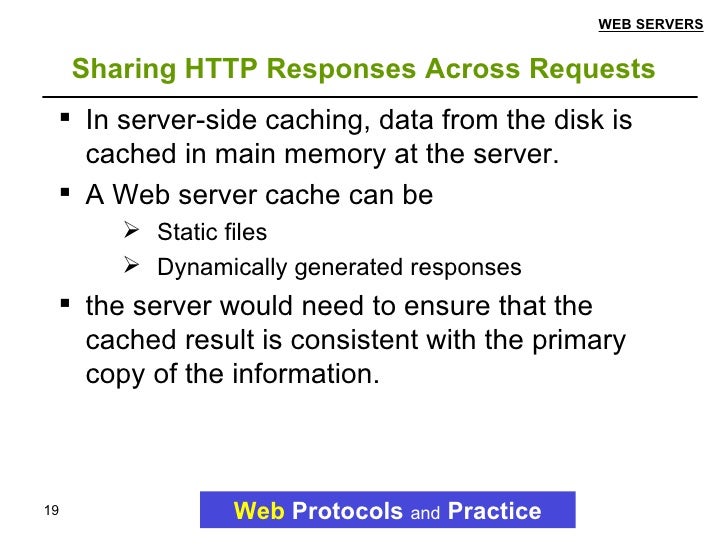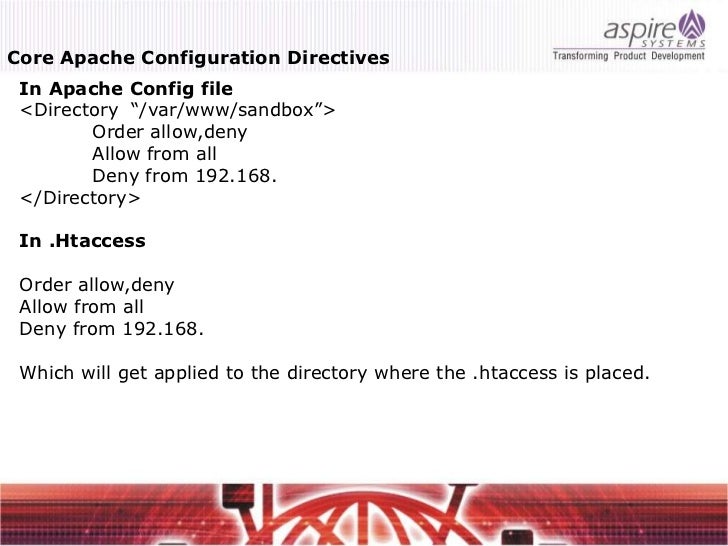But feel free to do it yourself. In all cases, Apache Bench and Jmeter did not run on the server machine. When the X1 is the server, the linux system was running AB/Jmeter. When the linux box is the server, the X1 was running AB/Jmeter. I must acknowledge Sarvega corporation for their assistance. They were kind enough to run some. The PowerPoint PPT presentation: 'Apache Web Server' is the property of its rightful owner. Apache Rivet extends the Tcl language with new commands aimed at providing a program interface to the web server and several utilities that usually come handy in web programming. Current version 3.1 of Rivet runs on Apache 2.4 and builds on both Windows and any reasonably recent version of Unix-like operative systems.
What is Apache Web Server?
Apache HTTP Server is a free and open-source web server that delivers web content through the internet. It is commonly referred to as Apache and after development, it quickly became the most popular HTTP client on the web. It’s widely thought that Apache gets its name from its development history and process of improvement through applied patches and modules but that was corrected back in 2000. It was revealed that the name originated from the respect of the Native American tribe for its resiliency and durability.
Metabase and Superset belong to 'Business Intelligence' category of the tech stack. 'Database visualisation' is the primary reason why developers consider Metabase over the competitors, whereas 'Awesome interactive filtering' was stated as the key factor in picking Superset. Metabase and Superset. Metabase apparatus is developed on Clojure whereas Redash and Superset are based on Python. This helps you to decide which tool is favourable if your company uses the same platform – Python or Clojure. Superset, Looker, Kibana, Grafana, and Redash are the most popular alternatives and competitors to Metabase. 'Awesome interactive filtering' is the primary reason why developers choose Superset. A Single Source of Truth for Metabase and Apache Superset Power consistent reporting and analysis with Panoply. Sync and store data from over 30+ sources. Keep all your business units happy by connecting their favorite BI tools. Superset metabase. Overview Superset is fast, lightweight, intuitive, and loaded with options that make it easy for users of all skill sets to explore and visualize their data, from simple line charts to highly detailed geospatial charts. Powerful yet easy to use.

Now, before we get too in depth on Apache, we should first go over what a web application is and the standard architecture usually found in web apps.
Apache Web Application Architecture
Apache is just one component that is needed in a web application stack to deliver web content. One of the most common web application stacks involves LAMP, or Linux, Apache, MySQL, and PHP.
Linux is the operating system that handles the operations of the application. Apache is the web server that processes requests and serves web assets and content via HTTP. MySQL is the database that stores all your information in an easily queried format. PHP is the programming language that works with apache to help create dynamic web content.
While actual statistics may vary, it’s fair to say a large portion of web applications run on some form of the LAMP stack because it is easy to build and also free to use. For the most part, web applications tend to generally have similar architecture and structure even though they serve many different functions and purposes. Most web applications also benefit from Firewalls, Load Balancers, Web Servers, Content Delivery Networks, and Database Servers.
Firewalls help protect the web application from both external threats and internal vulnerabilities depending on where the firewalls are configured. Load Balancers help distribute traffic across the web servers which handle the HTTP(S) requests (this is where Apache comes in) and application servers (servers that handle the functionality and workload of the web app.) We also have Database Servers, which handle asset storage and backups. Depending on your infrastructure, your database and application can both live on the same server although it’s recommended to keep those separate.
Easily monitor and troubleshoot Apache web activity
Gain better insight into systems infrastructure, and your clients and customers' interactions with your website and applications.
Web Server Landscape
The internet is comprised of many different technologies and not all of them are the same. While Apache is arguably one of the most popular web servers out there on the net, there are many other players and the landscape is always changing. Back in the late 90s and early 2000s, Apache’s dominance was very strong, serving over 50% of the internet's active websites. Microsoft's IIS (Internet Information Services) was also an option but not nearly as popular.
Today, Apache still serves a large portion of the active websites but their share of the field has shrunk from 50% to just under 40% as of 2018 and NGINX, a relatively new player to the web server playing field, is in second place with roughly 35% and Microsoft IIS hovering around 8-10%. Every year there’s a new crop of web applications with new stacks and servers so the landscape is always changing.
Why Apache Web Servers?
Apache is considered open source software, which means the original source code is freely available for viewing and collaboration. Being open source has made Apache very popular with developers who have built and configured their own modules to apply specific functionality and improve on its core features. Firefox developer tools download full. Apache has been around since 1995 and is responsible as a core technology that helped spur the initial growth of the internet in its infancy.
One of the pros of Apache is its ability to handle large amounts of traffic with minimal configuration. It scales with ease and with its modular functionality at its core, you can configure Apache to do what you want, how you want it. You can also remove unwanted modules to make Apache more lightweight and efficient.
Some of the most popular modules that can be added are SSL, Server Side Programming Support (PHP), and Load Balancing configs to handle large amounts of traffic. Apache can also be deployed on Linux, MacOS, and Windows. If you learn how to configure Apache on Linux, you can administer Apache on Windows and Mac. The only difference would be directory paths and installation processes.
Apache Web Server Pdf

Features of Apache Web Server

- Handling of static files
- Loadable dynamic modules
- Auto-indexing
- .htaccess
- Compatible with IPv6
- Supports HTTP/2
- FTP connections
- Gzip compression and decompression
- Bandwidth throttling
- Perl, PHP, Lua scripts
- Load balancing
- Session tracking
- URL rewriting
- Geolocation based on IP address
How does Apache Web Server Work?
Apache functions as a way to communicate over networks from client to server using the TCP/IP protocol. Apache can be used for a wide variety of protocols, but the most common is HTTP/S. HTTP/S or Hyper Text Transfer Protocol (S stands for Secure) is one of the main protocols on the web, and the one protocol Apache is most known for.
HTTP/S is used to define how messages are formatted and transmitted across the web, with instructions for browsers and servers on how to respond to various requests and commands. Hypertext Transfer Protocol Secure is usually through port 443 with the unsecured protocol being through port 80.

The Apache server is configured via config files in which modules are used to control its behavior. By default, Apache listens to the IP addresses configured in its config files that are being requested. This is where one of Apaches many strengths come into play.
With the Listen directive, Apache can accept and route specific traffic to certain ports and domains based on specific address-port combination requests. By default, Listen runs on port 80 but Apache can be bound to different ports for different domains, allowing for many different websites and domains to be hosted and a single server. You can have domain1.com listening on port 80, domain2.com on port 8080 and domain3.com on port 443 using HTTPS all on Apache.
Once a message reaches its destination or recipient, it sends a notice, or ACK message, basically giving acknowledgment to the original sender that their data has successfully arrived. If there’s an error in receiving data, or some packets were lost in transit, the destination host or client sends a Not Acknowledged, or NAK message, to inform the sender that the data needs to be retransmitted.
Who Uses Apache Web Server?
Apache HTTP web servers are used by over 67% of all web servers in the world. Apache web servers are easy to customize environments, they’re fast, reliable, and highly secure. This makes Apache web servers a common choice by best-in-class companies.
Alternatives for Apache HTTP Server
While Apache web servers are very popular, they’re not the only web servers on the market. Below are a number of alternatives for Apache HTTP servers.
- Nginx
- Apache Tomcat
- Node.js
- Lighttpd
- Cherokee
- Microsoft IIS
- Appweb
- Hiawatha
Apache HTTP Server vs Tomcat
Apache Web Server Powerpoint
Simply put, Apache HTTP server is a web server designed to serve static web pages. Whereas, Apache Tomcat is an application server built to serve java applications. Download wps for mac. Web pages can still be served through Apache Tomcat, but it will be less efficient than using an Apache HTTP server.
Conclusion: Apache Web Server
Throughout the last few decades, Apache has proven to be a staple in many popular stacks and the backbone of the early internet year. While it’s popularity is declining and the options of web server choices are increasing, Apache still plays a pivotal role in many technology stacks and companies system infrastructure. Even with new technologies and servers coming out nonstop, Apache is still a technology every developer should learn how to handle and configure.
Easily monitor and troubleshoot Apache web activity
Sumo Logic helps you identify root issues, decrease downtime, increase availability, and improve overall system performance and user experience.

